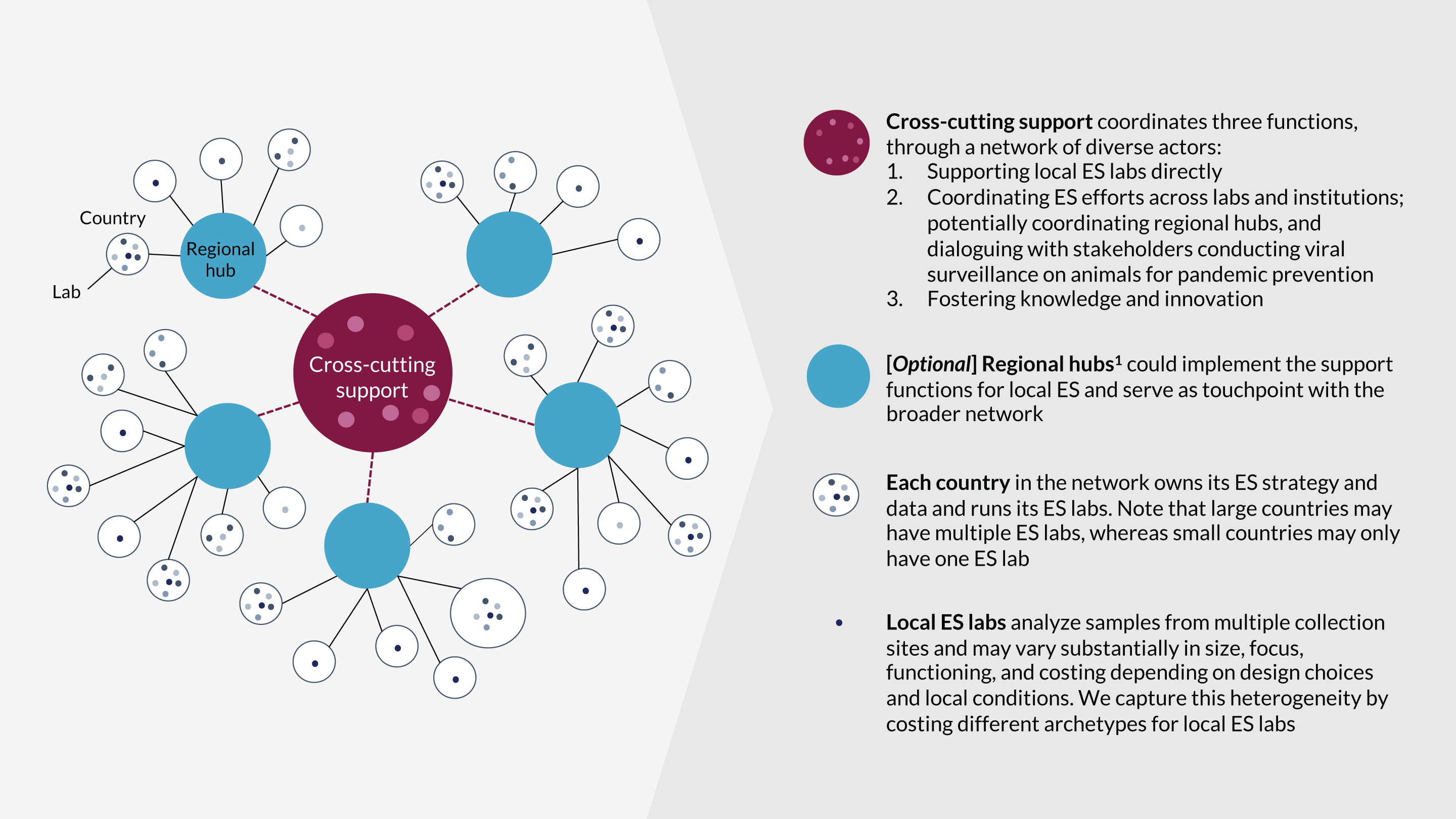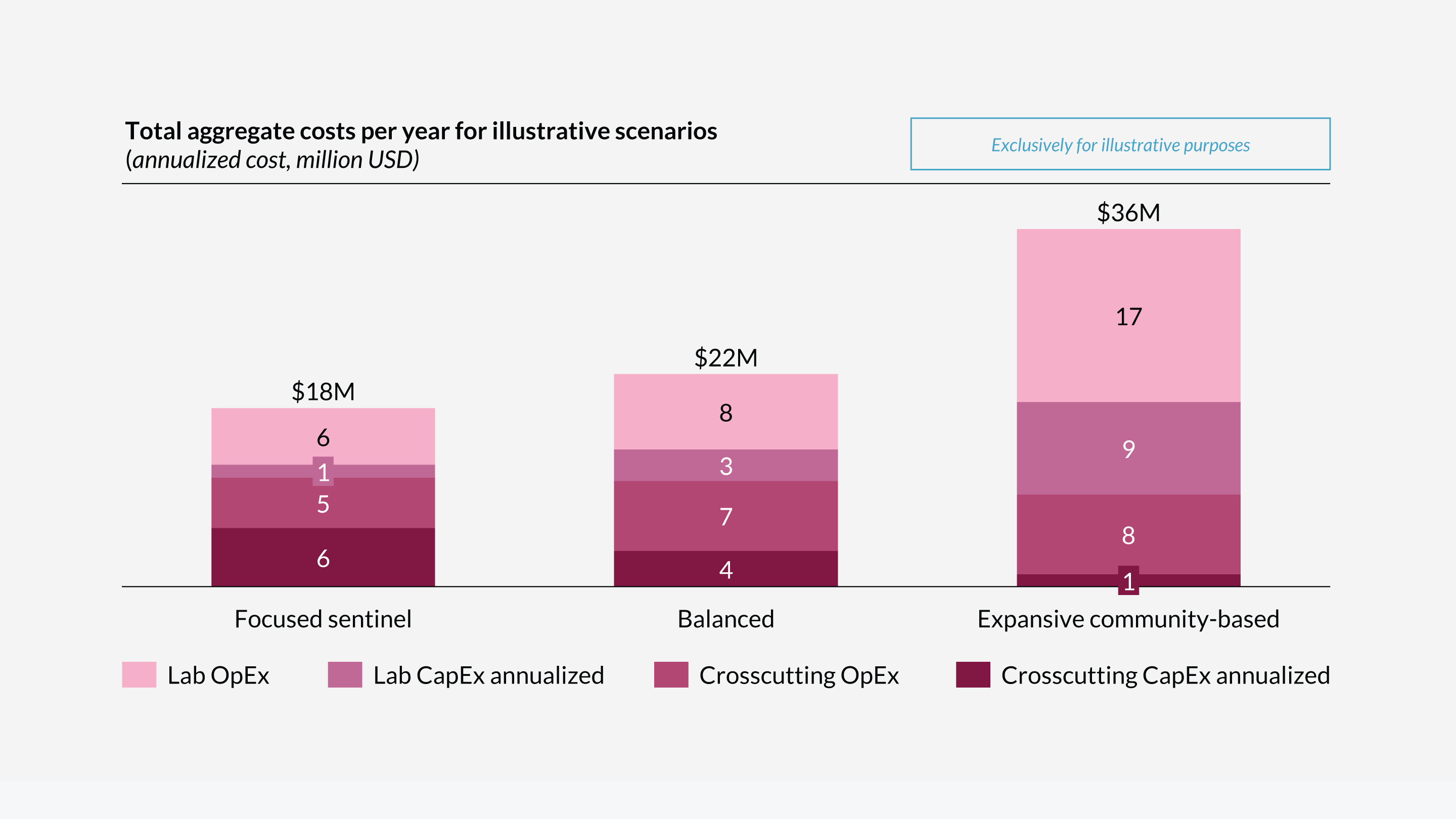Environmental surveillance is part of the “critical path” to pandemic preparedness and resilience, particularly in Low- and Middle- Income Countries. Costing environmental surveillance is a crucial step toward establishing a Global Environmental Surveillance System. Between March and June 2023, Dalberg worked closely with the Bill & Melinda Gates Foundation to cost a Global Environmental Surveillance System focused on LMICs. We interviewed over 20 experts across four continents and conducted a thorough literature review. Our insights are poised to inform a consortium of global health actors exploring its establishment.
The potential for a Global Environmental Surveillance System focused on LMICs
In the wake of the Covid-19 pandemic, it has become glaringly apparent that the world needs to be better prepared for future health crises. Seven million confirmed Covid-19 deaths, and over $12.5 trillion in economic costs later, the need for readiness is undeniable. Factors such as climate change and deforestation,¹ antimicrobial resistance, and the potential emergence of human-made pathogens are all contributing to the risk of novel infectious outbreaks. Meanwhile, far from the headlines, endemic communicable diseases, such as typhoid fever and cholera, disproportionately affect communities in Low- and Middle- Income Countries (LMICs), where they sometimes account for over half the disease burden.²
In response to these challenges, Environmental Surveillance (ES)³ is emerging as a vital public health tool to both warn against and effectively manage new threats and reduce the burden of existing communicable diseases. ES involves the detection of infectious agents in the environment, primarily in wastewater, and has been used effectively for decades to monitor and combat diseases like polio. As the patterns of communicable diseases evolve due to climate change and new threats loom, ES presents a promising solution at the intersection of health, climate, and environment. When adapted to their priorities, ES can directly benefit communities by tackling endemic diseases at the local transmission level.
A Global Environmental Surveillance System, focused on LMICs, would substantially benefit local laboratories, national health systems, and the world at large through sentinel surveillance. This entails monitoring disease trends within selected communities, for detection of and resilience to novel infectious diseases, which are more likely to emerge in LMICs due to zoonotic spillovers.⁴ Local communities would benefit from well-funded and assisted ES laboratories, conducting community-based surveillance, and from working closely with policymakers to reduce the burden of communicable diseases. National health systems could better allocate resources towards prevention and early containment rather than costly treatment. Regional and global health actors could respond quicker and more effectively to new or growing threats.
Costing the Global Environmental Surveillance System
To understand the cost implications of establishing a Global Environmental Surveillance System, Dalberg, in collaboration with the Bill & Melinda Gates Foundation, conducted extensive research and modeling. Below is an approximate breakdown of the costs involved:
Global ES System cost: In our median, balanced scenario focused on LMICs, we estimate an annualized cost of the global ES system of $22 million, covering multiple pathogens and integrating 100 ES labs, appropriately assisted, networked, and coordinated.⁵ Since the capital expenditure of setting up an individual ES lab is approximately $350,000, starting 100 new ES labs would cost $35 million. Nonetheless, the system could greatly benefit from leveraging existing ES efforts, mostly in Covid-19 and polio eradication, moderating the initial investments.⁶ Local and transnational funders may invest in establishing the ES system, or fund bottom-up ES initiatives by supporting local laboratories subsequently integrated into the ES system.
For costing purposes, we assumed the system could follow a hub and spoke model, with crosscutting support from the global or regional level directly assisting local ES labs, coordinating efforts, and fostering knowledge development through data quality and consolidation and technological innovation. If appropriately designed, the system would avoid redundancies while enabling countries to own and lead their ES efforts.

Figure 1: Hub and spoke design for a Global Environmental Surveillance System focused on LMICs.
A flexible Environmental Surveillance model cost
Costing an ES system is challenging, as costs vary significantly based on factors such as local labor markets, population density, sewage capacity, targeted pathogens, sampling frequency, existing infrastructure, and more. To address this challenge, Dalberg in collaboration with the Bill & Melinda Gates Foundation. developed a flexible costing model that considers costs at three levels:
- Individual ES lab, drawing inputs from over 20 expert interviews and multiple scientific studies, including ES costing data points from Malawi, Nepal, South Africa, Bangladesh, India, Kenya, and Pakistan.
- Network of ES labs, modelling potential economies of scale and synergies between labs at the national and regional levels.
- Crosscutting support, defining and costing several levels of ambition across global dimensions, including (1) assisting local ES directly with technical assistance and procurement, (2) convening and coordinating ES internationally, and (3) fostering knowledge and innovation, through data quality and consolidation, and technological and epidemiological research. This support could be delivered through a mix of global or regional hubs.
For each level, we built archetypes showcasing representative examples of ES systems, while allowing the user to tweak more than 30 costing parameters. The attached deck delves into our methodology, and the model is available upon request.
Costing estimates for Environmental Surveillance
Aggregating lab and crosscutting support costs, we modeled three illustrative scenarios for the global ES system focused on LMICs, yielding total annualized costs between $18 million and $36 million. The figure below breaks these costs between operational expenses (OpEx) and capital expenses (CapEx) at the lab and crosscutting levels, for the following three scenarios, with different areas of emphasis:
- Focused sentinel scenario (~$18 million), detecting disease outbreaks in global urban hubs and stopping early transmission. The lab network would be relatively small, including ~50 ES labs in transit hubs and some zoonotic high-risk areas, while the crosscutting support would prioritize data integration and cutting-edge research
- Balanced scenario (~$22 million), tracking disease dynamics at both sentinel sites and community-based sites. We assume ~100 ES labs, with balanced priorities, and a medium level of ambition across all crosscutting support functions.
- Expansive community-based scenario (~$36 million), monitoring disease dynamics with a focus on last-mile health in low-resource settings. We built this scenario with ~250 labs, mostly focused on community-based ES in both sewered and unsewered areas. Crosscutting support would prioritize lab technical assistance, procurement, and coordination.

Figure 2: Total annualized costs for a Global Environmental Surveillance System based on illustrative design choices
For funders prioritizing local laboratory investments, our estimated annualized cost of running individual ES labs in LMICs ranges from ~$100,000 to ~$225,000 for a target population of one million people, depending on design choices, geographic accessibility, and economic context.⁷
Cost Distribution: Across different scenarios, the costs are primarily categorized into OpEx and CapEx. Personnel is the highest cost item (37%), followed by equipment and consumables (31% and 23% respectively). Recurrent OpEx thus accounts for ~70% of total annualized cost while CapEx, largely disbursed upfront, represents the remaining ~30%.
Lab Setup Cost: Setting up a new ES lab from scratch may require around $350,000, which includes lab equipment, transportation, cold chain logistics, and site setup.⁸ The cost per sample for most labs typically varies from ~$100 to ~$160.
At the system level, crosscutting support could cost between $4 million and $18 million per year, depending on the level of ambition. The main cost drivers for crosscutting support are the number of local laboratories assisted, the extent of the convening and networking of ES professionals, the depth and frequency of data integration, and the ambition of R&D grants for epidemiological and technological innovation.
Environmental surveillance is a rapidly evolving field. Further innovations, from high-sensitivity biosensors to cheaper next-generation sequencing techniques, may reduce the cost of high-quality ES. The consensus among our expert interviewees, nonetheless, was that substantial cost efficiencies were unlikely to occur in the next two or three years, while standardization and regulation is still needed for existing technologies and protocols.
What’s next? Building a Global System for Environmental Surveillance
The Covid-19 pandemic has highlighted the value of preparedness. As we grapple with how to become a safer, more prepared world, the epidemiological vulnerability of LMICs remains a pressing concern. There are, to make this vision a reality, several milestones to be achieved, bringing together the right mix of stakeholders:
- Define the purpose and objectives of the system, in close collaboration with LMICs’ health leaders, aligning national and global priorities. Whether the system prioritizes combating endemic disease or emerging threats will have implications on lab protocols (e.g., sampling frequency, sequencing techniques) and the nature of crosscutting investments (e.g., technical assistance vs. research).
- Gather a coalition of ES partners, including NGOs and the private sector, to foster collaboration, pool expertise, and enhance project outcomes. Members of coalition should share the purpose above, commit to engaging recurrently, have clear roles and understand other members’ value-add to the ecosystem.
- Secure funding, considering the balance of in-country vs. donor contributions as well as the time commitment for support. Donors should consider the funding gaps in the ES ecosystem as a whole to inform their investments and donations and work closely together to complement their efforts and avoid redundancies.
- Develop a governance structure unlocking the collective impact of all stakeholders. This structure should provide a backbone for the collective impact of the coalition, creating spaces and clear rules for collaboration and pushing a common agenda forward. Governance should balance speed and simplicity with the need to incorporate diverse voices, and allow for local, bottom-up influence.
- Refine the operating model to analyze the scope, scale, and resources to provide refined cost estimates for informed decision-making. This operating model should clarify the extent of in-house human resources and the incubation model for the initiative, potentially choosing an existing hosting organization. Finally, the global ES system should collaborate closely with stakeholders conducting viral surveillance on farm and wild animals to prevent pandemics at the source.
For more information or access to the model, please contact erin.barringer@dalberg.com



